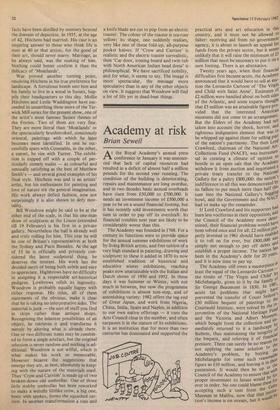Academy at risk
Brian Sewell
Athe Royal Academy's annual press conference in January it was announ- ced that lack of capital resources had resulted in a deficit of almost half a million pounds for the second year running. The condition of the building is deteriorating, repairs and maintenance are long overdue, and in two decades basic annual overheads have risen from £50,000 to £700,000. It needs an investment income of £500,000 a year to be on a sound financial footing, but it has recently sold investments worth that sum in order to pay off its overdraft. Its financial troubles next year are likely to be considerably worse than this.
The Academy was founded in 1768. For a century its functions were to provide space for the annual summer exhibitions of work by living British artists, and free tuition of a very high standard in painting, drawing and sculpture; to these it added in 1870 its now established tradition of historical and educative winter exhibitions, reaching peaks now unattainable with the Italian and Dutch shows of 1930 and 1952. In those days it was Summer or Winter, with not much in between, but now the programme of exhibitions is almost non-stop, and of astonishing variety: 1982 offers the tag end of Great Japan, and work from Nigeria, China, India, Spain and Naples, in addition to our own native offerings — it runs the Arts Council close in the number, and often surpasses it in the stature of its exhibitions. It is an institution that for more than two centuries has dominated and supported the Spectator 13 February 1982 practical arts and art education in this country, and it must not be allowed to falter: receiving aid from no government agency, it is about to launch an appeal for funds from the private sector, but it seems unlikely that it will raise the minimum of E5 million that must be necessary to put it on a sure footing. There is an alternative. Twenty years ago, when their financial difficulties first became acute, the AcademY announced that it would have to sell at auc- tion the Leonardo Cartoon of 'The Virgin and Child with Saint Anne'. Estimates of £2 million were bandied about on both sides of the Atlantic, and some experts thought that £5 million was an attainable figure pro- vided that the interested American museums did not come to an arrangement. But the Elders of the Academy had not taken into account the shock, horror, and righteous indignation element that was to be whipped up against them for selling Part, of the nation's patrimony. The then Lora Crawford, chairman of the National Art" Collections Fund (NACF), was instrumen- tal in creating a climate of opinion so hostile to an open sale that the AcademY withdrew it from auction and negotiated 3 private treaty transfer to the National Gallery for a paltry £800,000: the nations indifference to all this was demonstrated by its failure to put much more than half this sum into the National Gallery's begging bowl, and the Government and the NACF had to make up the remainder. If Lord Crawford and his supporters had, been less vociferous in their opposition, and the Council of the Academy more deter" mined, their financial problems would have been solved once and for all: £2 million Pro:, perly invested in 1961 should have enable' it to roll on for ever, but £800,000 wa,s simply not enough to pay off debts an establish a proper income. The nation has been in the Academy's debt for 20 Years' and it is now time to pay up. The Academy still owns a masterpiece at least the equal of the Leonardo Cartoon the tondo of 'The Virgin and Child' b)i. Michelangelo, given to it by the farnilqi, Sir George Beaumont in 1830. In 1,9L'v acute tax problems that might oa „e prevented the transfer of Count Seilernh; £30 million bequest of paintings to the Courtauld Institute, were solved by the d tervention of the National Heritage Fawn, and the Victoria and Albert Museum' which bought from the collection and I', by- mediately returned to it a landscape f „ Rubens, thus maintaining the integritY;a1 the bequest, and relieving it of fin° col pressure. There can surely be no reason t"he not applying the same solution to the Academy's problem, by buying ble Michelangelo for some such reasona_ett. figure as £10 million, and leaving it tot"the possession. It would then be up t0witii Council of the Academy to ensure that for proper investment its house would be for ever in order. No one could blame theiletty accepting such a sum from the tita- Museum in Malibu, now that that in'ict be tion's income is on stream, but it woa'
hateful to experience again the backbiting of 20 years ago, disastrous to our heritage to lose the Michelangelo, and immeasurably damaging to the cultural life of the nation to lose the Academy.











































 Previous page
Previous page